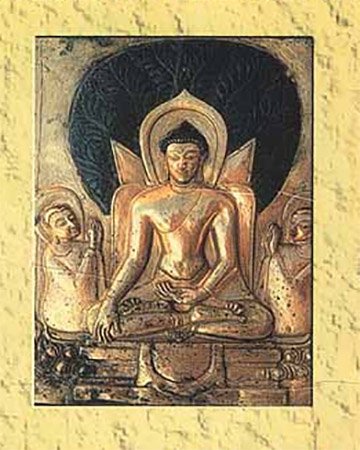The Mahavastu (great story)
by J. J. Jones | 1949 | 502,133 words | ISBN-10: 086013041X
This page describes goatherd’s banyan tree which is Chapter XXVII of the English translation of the Mahavastu (“great story”), dating to the 2nd-century BC. This work belongs to the Mahasanghika school of early Buddhism and contains narrative stories of the Buddha’s former lives, such as Apadanas, Jatakas and more..
Chapter XXVII - The goatherd’s banyan tree
When the Exalted One, the perfect Buddha, was living his life of austerity on the banks of the river Nairañjanā, he was seen by a goatherd. Now when the goatherd saw the Exalted One mortifying himself with these grim austerities faith arose in him. With serene heart he planted a young banyan tree for the Exalted One. When he had planted this young banyan tree, he went to the Exalted One, held out his joined hands, and said to him, “Lord, I planted this young banyan tree for the Exalted One, believing that when the banyan tree should have grown to its full size, the Exalted One would have achieved his aim. So, for my sake, be pleased to make use of this banyan tree.” The Exalted One silently intimated his assent to the goatherd.
When the goatherd perceived this silent assent he became glad, exultant, delighted, pleased, joyful and content. From time to time he would dig about and around the banyan tree, stake it and hoe[1] around it. From time to time he would water and sprinkle it by pouring cool water on and around it. Thus the goatherd’s[2] young banyan tree quickly grew to have great branches and to be a lovely and beautiful tree through the power of the Exalted One.
(302) And when the goatherd saw the young banyan tree grown into a lovely and beautiful tree with its branches spreading downwards and outwards,[3] his heart became exceeding serene. In virtue of that serenity of heart and his root of merit, on the dissolution of his body he was reborn among the devas of Trāyastriṃśa as a deva named Nyagrodha[4] possessing great majesty and power. Though he had been reborn there later than they, he excelled the other devas born before him in Trāyastriṃśa in the five[5] deva attributes of length of life, complexion, happiness, dominion and retinue. As soon as he was reborn there this reflection occurred to him: “What fair karma did I contract and store up when I was a human being? As the maturing of what karma have I been reborn here in the world of the Trāyastriṃśa devas?”
Then the deva Nyagrodha, while he was thus pondering what his root of merit might be, saw the banyan tree which he had planted for the Exalted One on the banks of the river Nairañjanā. And so, accompanied by several thousands of devas, the deva Nyagrodha, in his surpassing beauty irradiating the whole abode of Mucilinda with a sublime radiance, came to the Exalted One, bowed his head at his feet and stood to one side. Arranging his robe over one shoulder and holding out his joined hands, he said to the Exalted One, “Lord, when I was a human being and a goatherd looking after my goats, I planted this banyan tree for the Exalted One. As a result of that root of merit, when I passed away from among men I was reborn among the deva hosts of Trāyastriṃśa. Well would it be if the Exalted One would take pity on me and make use of this banyan tree, so that thereby I may have a greater reward still.”
The Exalted One silently intimated his assent to the deva. And the deva perceiving the Exalted One’s silent assent, was glad, thrilled, exultant, joyful and content. He bowed his head at the Exalted One’s feet, saluted him thrice from the right, and then departed.
Footnotes and references:
[1]:
Parikuḍḍāleti, a conjecture of Senart’s, explained as a denominative of kuddāla. In his note on the word he would favour dd instead of ḍḍ, in spite of the evidence of the MSS. Edgerton (B.H.S.D.) suggests “walls about,” as the MSS. have parikudeti,—kūḍyeti, denominative of kūḍya, “wall”.
[2]:
Ajapālena, instr. for gen.
[3]:
Ośakhapraśakha. For this story about the Goatherd’s Banyan-tree see also Beal: Romantic legend of the Buddha, pp. 192, 238.
[4]:
Or, translated, Banyan.
[5]:
Elsewhere numbered as ten. See e.g., vol. 1, p. 25; 2, pp. 183, 350.
